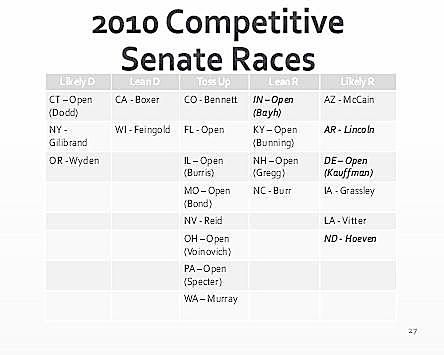The Coming GOP Tsunami
 Barring a sharp reversal of trends, voters are about to sweep away the Democratic majority in the House and (at least) throw control of the Senate into question.
Barring a sharp reversal of trends, voters are about to sweep away the Democratic majority in the House and (at least) throw control of the Senate into question.
A rogue wave is headed our way. Barring a sharp reversal of current trends, American voters are about to sweep away the Democratic majorities in the U.S. House of Representatives and, at a minimum, throw control of the U.S. Senate into serious question. My updated analysis shows stark changes in the electoral environment over the past six months with the playing field in the House of Representatives having grown by 50 percent (from 80 seats to 120 seats) with almost all of that growth among seats currently held by Democrats.
Here’s how desperate the situation has become for President Obama and Democrats in Congress: except for a short stretch along the Delaware Turnpike, it is now possible to drive from New Hampshire to Miami without encountering a seriously competitive Republican-held House seat. If you’d rather go West, start in Virginia Beach and drive to San Francisco. You won’t find any vulnerable Republicans on that axis. A map that six months ago was dotted with red and blue pins representing competitive seats held by both parties is now almost uniformly blue.
As I noted in January, the Northeast and Mid-Atlantic remain pivotal regions for the 2010 mid-terms. There are now a total of 24 endangered Democratic seats between New Hampshire and the North Carolina line. The previously competitive Republican seats in the region (apart from Congressman Mike Castle’s in Delaware) have almost evaporated. For Democrats it is all defense, all the time from here to November 2.
For Republicans, the good news continues to grow elsewhere in the country. Five incumbent Democrats are on the bubble in Ohio, and no Republicans. Two more in Indiana (and no Republicans). Three more Democrat-held seats in Tennessee, three in North Carolina, and four in Florida. (Weakness in the mid-South is an unusually strong harbinger of bad tidings for Democrats. On Election night, 1994, the Republican sweep took out Democrats in the governorship, two Senate seats (both were open due to a retirement), and three House seats. That’s what’s called a “bad night” in politics.) Both Dakota seats are likely to flip; two in Arkansas and between two and four seats in Arizona where the debate on policies to control illegal immigration will drive conservative turnout. And all of this is occurring against the backdrop of just four vulnerable Republican seats across the entire country. On a net basis, Republicans are already in excellent position to pick up 52 to 54 seats in the House of Representatives. Given the potential downside of a deteriorating economy, ballooning deficits, the ongoing crisis in the Gulf of Mexico and stackable foreign policy dramas, it takes only a modicum of imagination to see how things could get worse for the President’s party in the House.
Typically, such strong trends for House incumbents would be amplified in the U.S. Senate races, and so far this year is not an exception. The chart below lays out the current terrain:
Over the past six months there has been a steady shift toward the GOP. Republicans are virtually assured pick-ups in Arkansas, Delaware and North Dakota. Indiana looks ready to return Dan Coats to the Senate. Republicans are in position to retain seats in Kentucky, New Hampshire and North Carolina and are challenging strongly in Pennsylvania, Colorado, and Illinois. Ohio will likely remain a toss-up for some time although recent polls indicate former Congressman and OMB Director Rob Portman may be gaining a slight advantage. Democratic strongholds like California and Washington State are suddenly cage-matches and even Oregon Senator Ron Wyden is under 50 against a relatively unknown challenger. The only states in which the Democrats look stronger now than they did six months ago are Nevada, where Majority Leader Harry Reid continues to show he knows how to take a punch, and Connecticut, where Chris Dodd bowed out in favor of Attorney General Richard Blumenthal. The floor for Republican Senate gains this year starts at four seats. A last-minute collapse of morale in the Democratic base could drive GOP gains into the double digits.
Of course, winning House and Senate majorities may be the easy part. Managing the Republican coalition will be a much larger challenge. We can anticipate that many of the newly-elected members of the House and Senate, carried on this rogue wave, will want and press for immediate sweeping changes in policy and spending reductions – in short a confrontation with the President. Given divided government through at least 2012, we can further expect that the new Congress will be unable to enact such changes, at least not on the scale that would satisfy these new members and the voters who elected them (see the vocal disappointment on the political left with the first two years of the Obama Administration). A new cohort of Gypsy-moth Republicans from the Northeast will act as a brake on the conservative majority and the White House will resurrect the bogey of slash-and-burn Republicanism in an effort to triangulate its way to re-election. Not pretty, potentially dangerous – and still the last best hope of man on earth.


